Comprehensive Marketing Plan Project: Fast Food Corporation Analysis
VerifiedAdded on 2020/03/23
|163
|28402
|29
Project
AI Summary
This project presents a comprehensive marketing plan analysis focusing on a fast food corporation, likely McDonald's, adapting to the Indian market. It includes an overview of the company's objectives, marketing campaigns, and strategies, such as local sourcing, cultural adaptation, and community partnerships. The project examines the marketing mix, promotional strategies, and the corporation's approach to market dominance. It analyzes the company's objectives from both a company and consumer perspective, including the analysis of an advertising budget. Furthermore, it explores legal considerations and proposes research surveys to understand consumer perceptions. The project provides a detailed budget breakdown across various marketing categories, including public relations, web marketing, advertising, collateral, events, direct marketing, and channel marketing programs. The analysis includes a summary of the budget allocation across different quarters and a demographic profile to identify the ideal client. The project provides insights into the corporation's expansion plans, market adaptation, and consumer loyalty, offering a detailed view of its marketing activities and budget allocation.
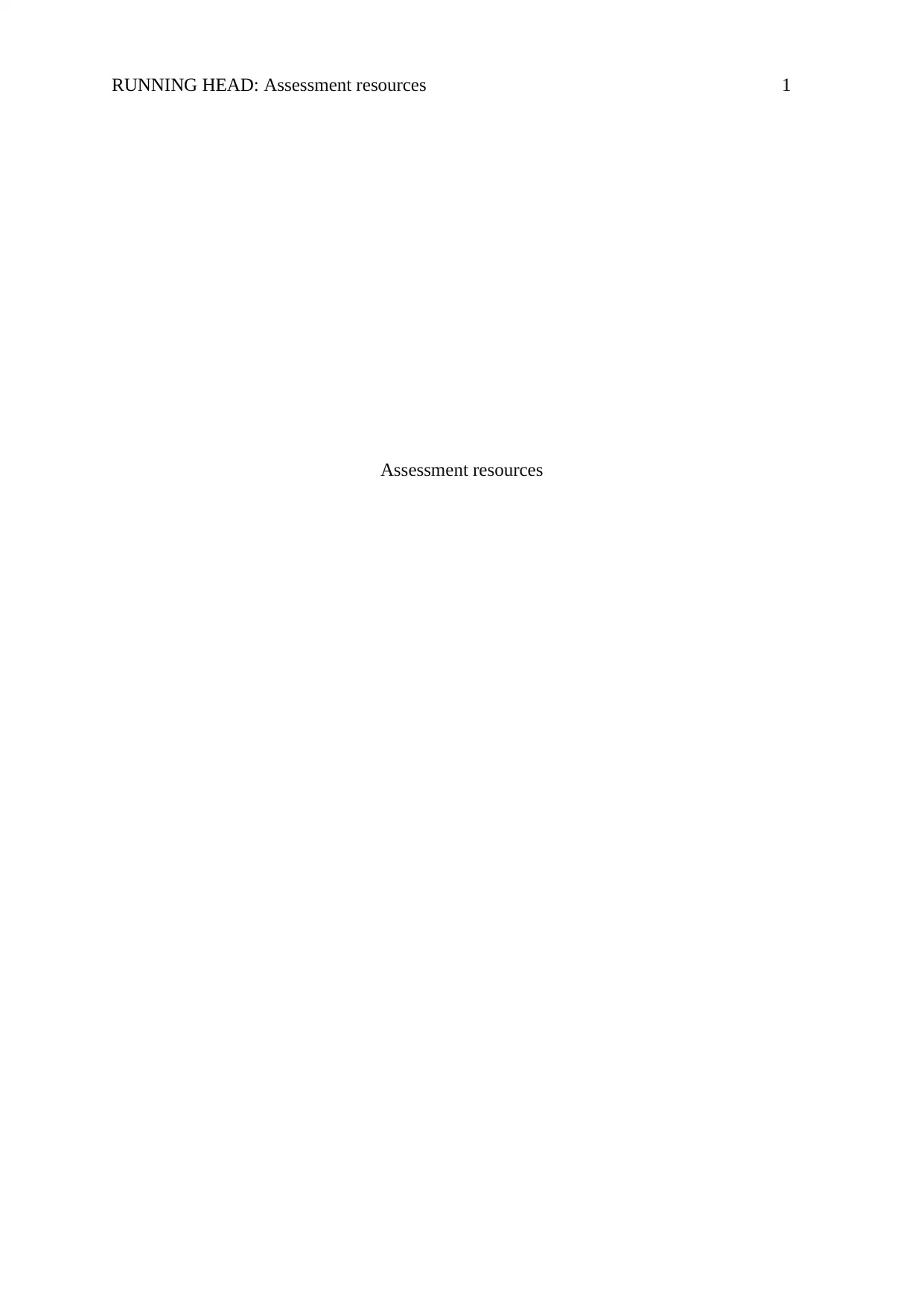
RUNNING HEAD: Assessment resources 1
Assessment resources
Assessment resources
Paraphrase This Document
Need a fresh take? Get an instant paraphrase of this document with our AI Paraphraser
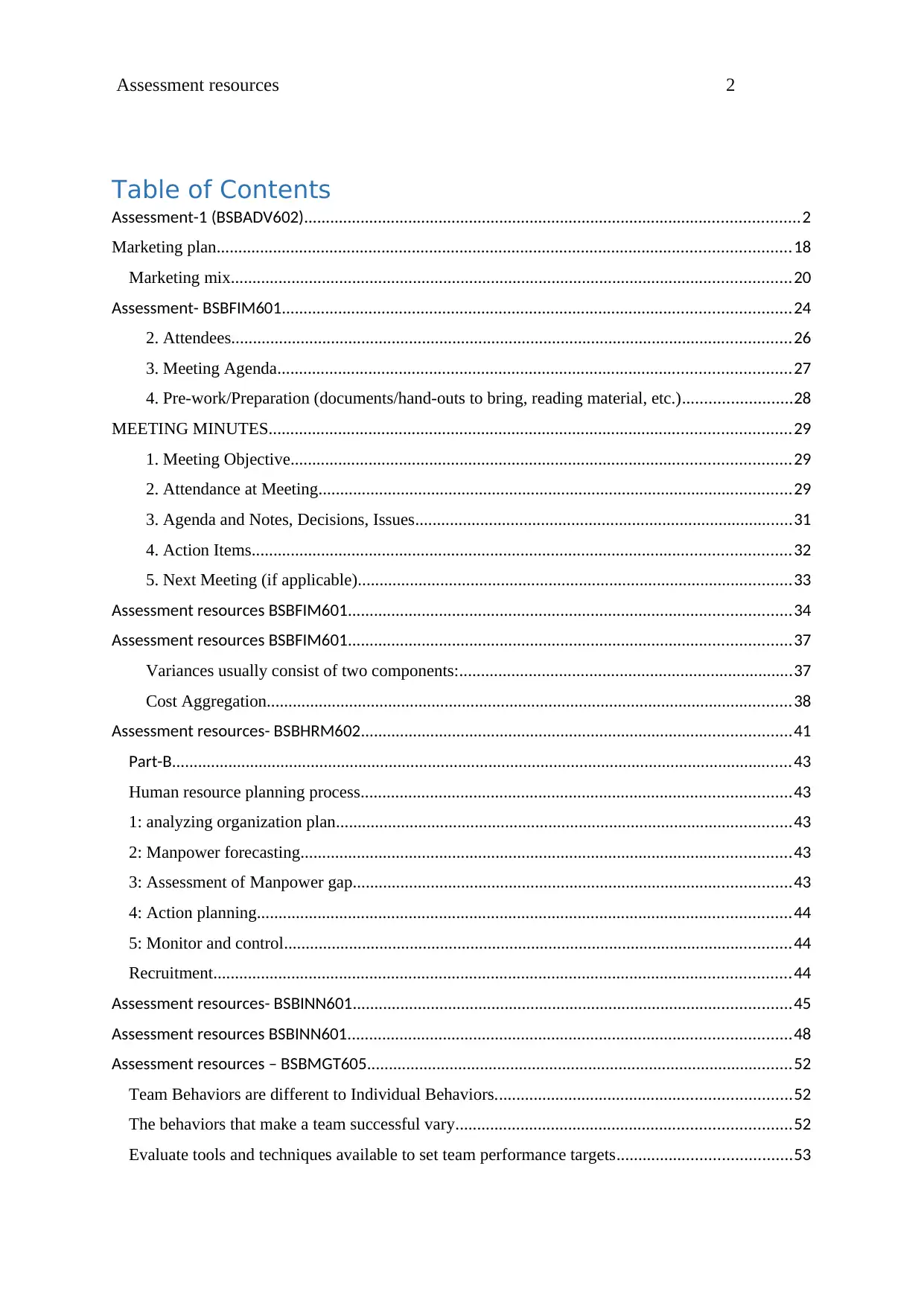
Assessment resources 2
Table of Contents
Assessment-1 (BSBADV602)..................................................................................................................2
Marketing plan....................................................................................................................................18
Marketing mix.................................................................................................................................20
Assessment- BSBFIM601.....................................................................................................................24
2. Attendees.................................................................................................................................26
3. Meeting Agenda......................................................................................................................27
4. Pre-work/Preparation (documents/hand-outs to bring, reading material, etc.).........................28
MEETING MINUTES........................................................................................................................29
1. Meeting Objective...................................................................................................................29
2. Attendance at Meeting.............................................................................................................29
3. Agenda and Notes, Decisions, Issues.......................................................................................31
4. Action Items............................................................................................................................32
5. Next Meeting (if applicable)....................................................................................................33
Assessment resources BSBFIM601......................................................................................................34
Assessment resources BSBFIM601......................................................................................................37
Variances usually consist of two components:.............................................................................37
Cost Aggregation.........................................................................................................................38
Assessment resources- BSBHRM602...................................................................................................41
Part-B...............................................................................................................................................43
Human resource planning process...................................................................................................43
1: analyzing organization plan.........................................................................................................43
2: Manpower forecasting.................................................................................................................43
3: Assessment of Manpower gap.....................................................................................................43
4: Action planning...........................................................................................................................44
5: Monitor and control.....................................................................................................................44
Recruitment.....................................................................................................................................44
Assessment resources- BSBINN601.....................................................................................................45
Assessment resources BSBINN601......................................................................................................48
Assessment resources – BSBMGT605..................................................................................................52
Team Behaviors are different to Individual Behaviors....................................................................52
The behaviors that make a team successful vary.............................................................................52
Evaluate tools and techniques available to set team performance targets........................................53
Table of Contents
Assessment-1 (BSBADV602)..................................................................................................................2
Marketing plan....................................................................................................................................18
Marketing mix.................................................................................................................................20
Assessment- BSBFIM601.....................................................................................................................24
2. Attendees.................................................................................................................................26
3. Meeting Agenda......................................................................................................................27
4. Pre-work/Preparation (documents/hand-outs to bring, reading material, etc.).........................28
MEETING MINUTES........................................................................................................................29
1. Meeting Objective...................................................................................................................29
2. Attendance at Meeting.............................................................................................................29
3. Agenda and Notes, Decisions, Issues.......................................................................................31
4. Action Items............................................................................................................................32
5. Next Meeting (if applicable)....................................................................................................33
Assessment resources BSBFIM601......................................................................................................34
Assessment resources BSBFIM601......................................................................................................37
Variances usually consist of two components:.............................................................................37
Cost Aggregation.........................................................................................................................38
Assessment resources- BSBHRM602...................................................................................................41
Part-B...............................................................................................................................................43
Human resource planning process...................................................................................................43
1: analyzing organization plan.........................................................................................................43
2: Manpower forecasting.................................................................................................................43
3: Assessment of Manpower gap.....................................................................................................43
4: Action planning...........................................................................................................................44
5: Monitor and control.....................................................................................................................44
Recruitment.....................................................................................................................................44
Assessment resources- BSBINN601.....................................................................................................45
Assessment resources BSBINN601......................................................................................................48
Assessment resources – BSBMGT605..................................................................................................52
Team Behaviors are different to Individual Behaviors....................................................................52
The behaviors that make a team successful vary.............................................................................52
Evaluate tools and techniques available to set team performance targets........................................53
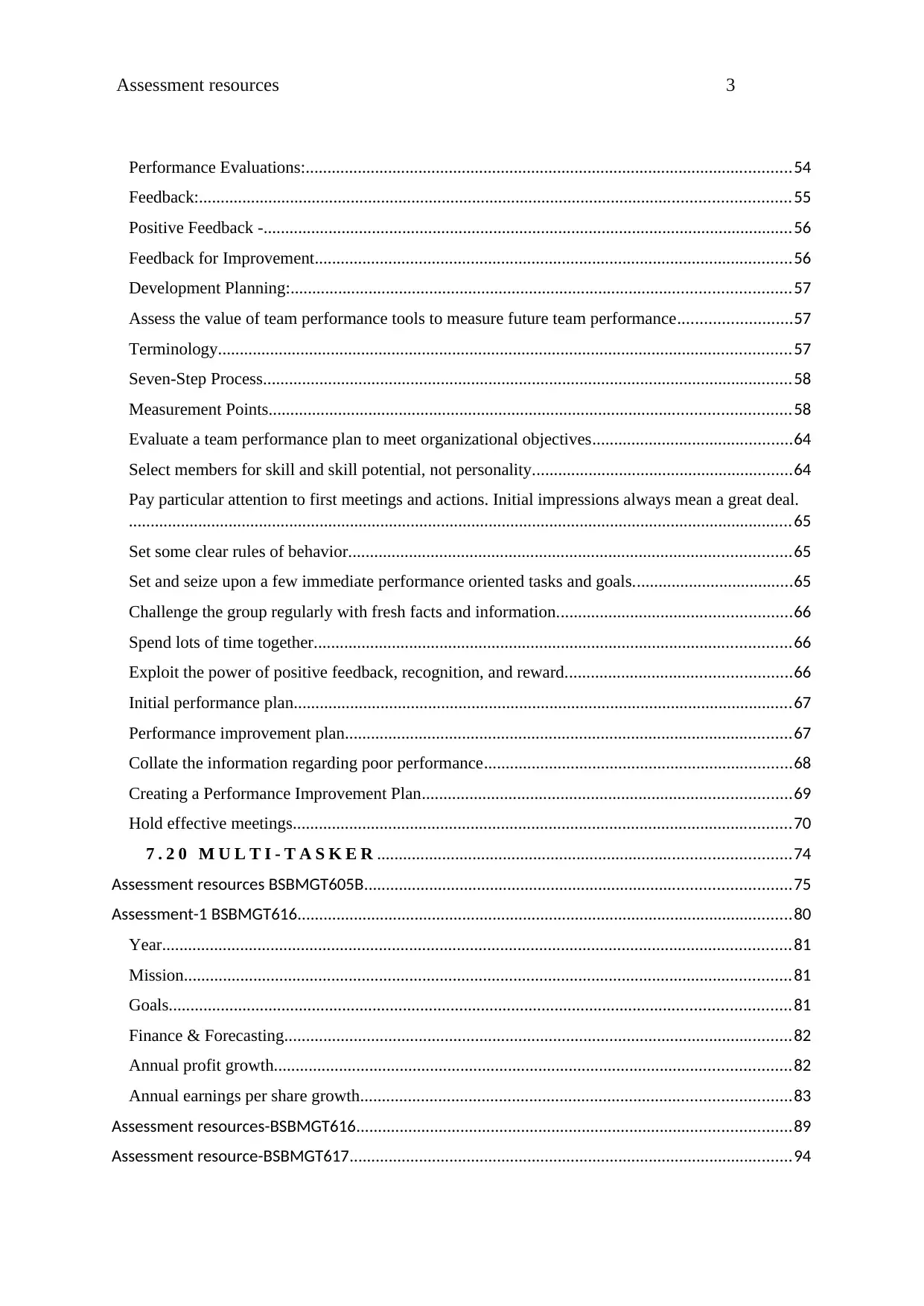
Assessment resources 3
Performance Evaluations:................................................................................................................54
Feedback:........................................................................................................................................55
Positive Feedback -..........................................................................................................................56
Feedback for Improvement..............................................................................................................56
Development Planning:...................................................................................................................57
Assess the value of team performance tools to measure future team performance..........................57
Terminology....................................................................................................................................57
Seven-Step Process..........................................................................................................................58
Measurement Points........................................................................................................................58
Evaluate a team performance plan to meet organizational objectives..............................................64
Select members for skill and skill potential, not personality............................................................64
Pay particular attention to first meetings and actions. Initial impressions always mean a great deal.
.........................................................................................................................................................65
Set some clear rules of behavior......................................................................................................65
Set and seize upon a few immediate performance oriented tasks and goals.....................................65
Challenge the group regularly with fresh facts and information......................................................66
Spend lots of time together..............................................................................................................66
Exploit the power of positive feedback, recognition, and reward....................................................66
Initial performance plan...................................................................................................................67
Performance improvement plan.......................................................................................................67
Collate the information regarding poor performance.......................................................................68
Creating a Performance Improvement Plan.....................................................................................69
Hold effective meetings...................................................................................................................70
7 . 2 0 M U L T I - T A S K E R ...............................................................................................74
Assessment resources BSBMGT605B..................................................................................................75
Assessment-1 BSBMGT616..................................................................................................................80
Year.................................................................................................................................................81
Mission............................................................................................................................................81
Goals...............................................................................................................................................81
Finance & Forecasting.....................................................................................................................82
Annual profit growth.......................................................................................................................82
Annual earnings per share growth...................................................................................................83
Assessment resources-BSBMGT616....................................................................................................89
Assessment resource-BSBMGT617......................................................................................................94
Performance Evaluations:................................................................................................................54
Feedback:........................................................................................................................................55
Positive Feedback -..........................................................................................................................56
Feedback for Improvement..............................................................................................................56
Development Planning:...................................................................................................................57
Assess the value of team performance tools to measure future team performance..........................57
Terminology....................................................................................................................................57
Seven-Step Process..........................................................................................................................58
Measurement Points........................................................................................................................58
Evaluate a team performance plan to meet organizational objectives..............................................64
Select members for skill and skill potential, not personality............................................................64
Pay particular attention to first meetings and actions. Initial impressions always mean a great deal.
.........................................................................................................................................................65
Set some clear rules of behavior......................................................................................................65
Set and seize upon a few immediate performance oriented tasks and goals.....................................65
Challenge the group regularly with fresh facts and information......................................................66
Spend lots of time together..............................................................................................................66
Exploit the power of positive feedback, recognition, and reward....................................................66
Initial performance plan...................................................................................................................67
Performance improvement plan.......................................................................................................67
Collate the information regarding poor performance.......................................................................68
Creating a Performance Improvement Plan.....................................................................................69
Hold effective meetings...................................................................................................................70
7 . 2 0 M U L T I - T A S K E R ...............................................................................................74
Assessment resources BSBMGT605B..................................................................................................75
Assessment-1 BSBMGT616..................................................................................................................80
Year.................................................................................................................................................81
Mission............................................................................................................................................81
Goals...............................................................................................................................................81
Finance & Forecasting.....................................................................................................................82
Annual profit growth.......................................................................................................................82
Annual earnings per share growth...................................................................................................83
Assessment resources-BSBMGT616....................................................................................................89
Assessment resource-BSBMGT617......................................................................................................94
⊘ This is a preview!⊘
Do you want full access?
Subscribe today to unlock all pages.

Trusted by 1+ million students worldwide
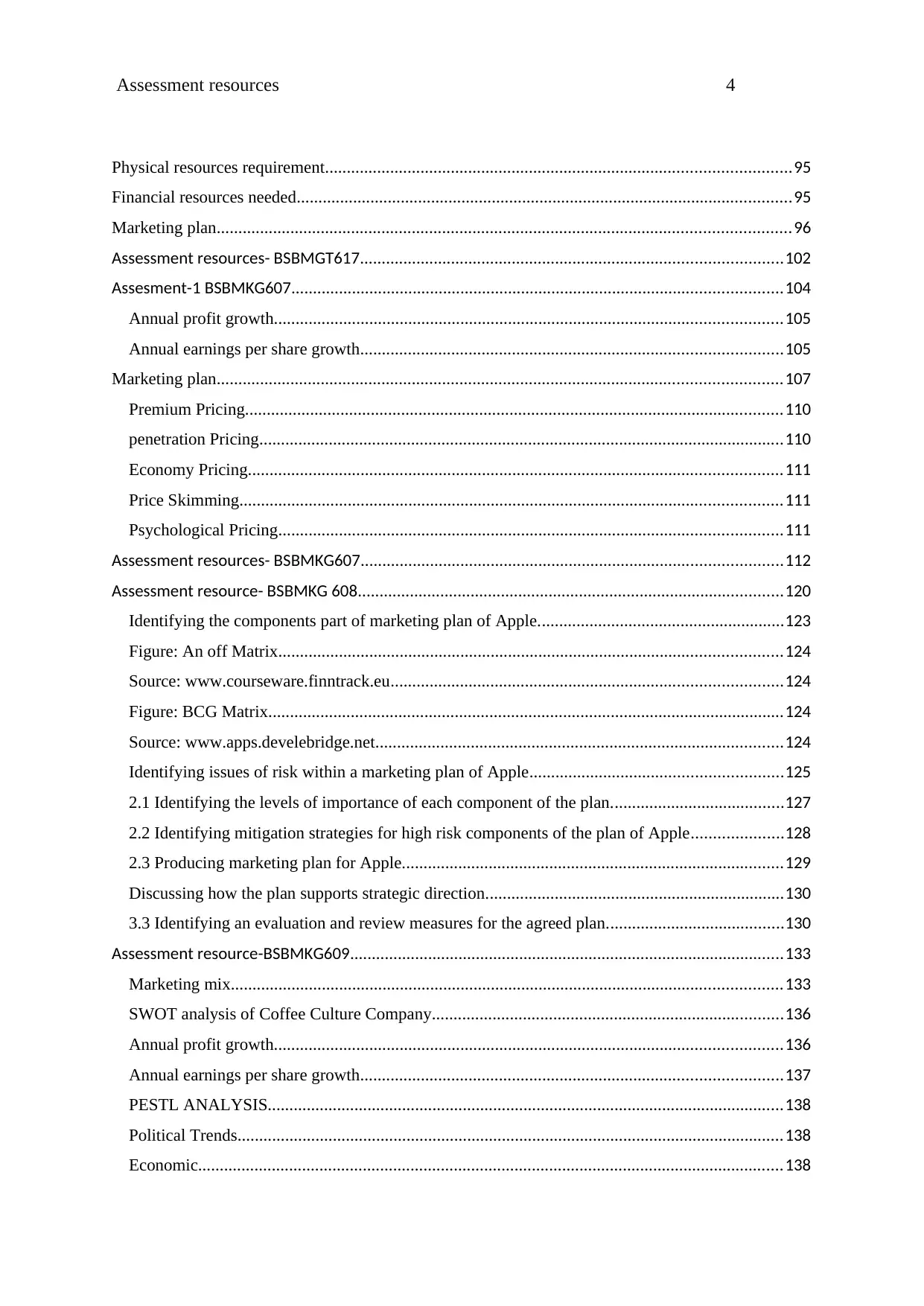
Assessment resources 4
Physical resources requirement...........................................................................................................95
Financial resources needed..................................................................................................................95
Marketing plan....................................................................................................................................96
Assessment resources- BSBMGT617.................................................................................................102
Assesment-1 BSBMKG607.................................................................................................................104
Annual profit growth.....................................................................................................................105
Annual earnings per share growth.................................................................................................105
Marketing plan..................................................................................................................................107
Premium Pricing............................................................................................................................110
penetration Pricing.........................................................................................................................110
Economy Pricing...........................................................................................................................111
Price Skimming.............................................................................................................................111
Psychological Pricing....................................................................................................................111
Assessment resources- BSBMKG607.................................................................................................112
Assessment resource- BSBMKG 608..................................................................................................120
Identifying the components part of marketing plan of Apple.........................................................123
Figure: An off Matrix....................................................................................................................124
Source: www.courseware.finntrack.eu..........................................................................................124
Figure: BCG Matrix.......................................................................................................................124
Source: www.apps.develebridge.net..............................................................................................124
Identifying issues of risk within a marketing plan of Apple..........................................................125
2.1 Identifying the levels of importance of each component of the plan........................................127
2.2 Identifying mitigation strategies for high risk components of the plan of Apple.....................128
2.3 Producing marketing plan for Apple........................................................................................129
Discussing how the plan supports strategic direction.....................................................................130
3.3 Identifying an evaluation and review measures for the agreed plan.........................................130
Assessment resource-BSBMKG609....................................................................................................133
Marketing mix...............................................................................................................................133
SWOT analysis of Coffee Culture Company.................................................................................136
Annual profit growth.....................................................................................................................136
Annual earnings per share growth.................................................................................................137
PESTL ANALYSIS.......................................................................................................................138
Political Trends..............................................................................................................................138
Economic.......................................................................................................................................138
Physical resources requirement...........................................................................................................95
Financial resources needed..................................................................................................................95
Marketing plan....................................................................................................................................96
Assessment resources- BSBMGT617.................................................................................................102
Assesment-1 BSBMKG607.................................................................................................................104
Annual profit growth.....................................................................................................................105
Annual earnings per share growth.................................................................................................105
Marketing plan..................................................................................................................................107
Premium Pricing............................................................................................................................110
penetration Pricing.........................................................................................................................110
Economy Pricing...........................................................................................................................111
Price Skimming.............................................................................................................................111
Psychological Pricing....................................................................................................................111
Assessment resources- BSBMKG607.................................................................................................112
Assessment resource- BSBMKG 608..................................................................................................120
Identifying the components part of marketing plan of Apple.........................................................123
Figure: An off Matrix....................................................................................................................124
Source: www.courseware.finntrack.eu..........................................................................................124
Figure: BCG Matrix.......................................................................................................................124
Source: www.apps.develebridge.net..............................................................................................124
Identifying issues of risk within a marketing plan of Apple..........................................................125
2.1 Identifying the levels of importance of each component of the plan........................................127
2.2 Identifying mitigation strategies for high risk components of the plan of Apple.....................128
2.3 Producing marketing plan for Apple........................................................................................129
Discussing how the plan supports strategic direction.....................................................................130
3.3 Identifying an evaluation and review measures for the agreed plan.........................................130
Assessment resource-BSBMKG609....................................................................................................133
Marketing mix...............................................................................................................................133
SWOT analysis of Coffee Culture Company.................................................................................136
Annual profit growth.....................................................................................................................136
Annual earnings per share growth.................................................................................................137
PESTL ANALYSIS.......................................................................................................................138
Political Trends..............................................................................................................................138
Economic.......................................................................................................................................138
Paraphrase This Document
Need a fresh take? Get an instant paraphrase of this document with our AI Paraphraser
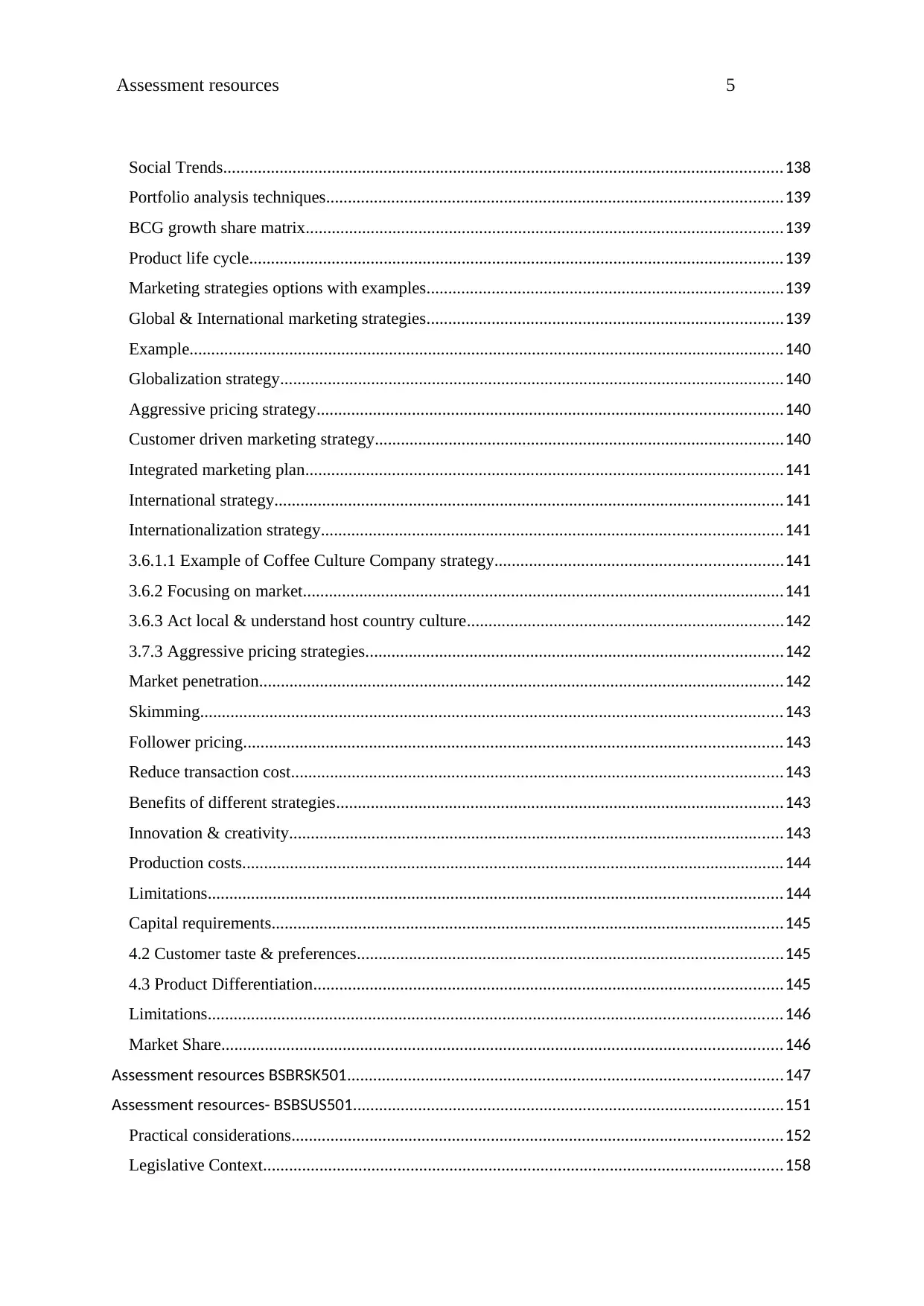
Assessment resources 5
Social Trends.................................................................................................................................138
Portfolio analysis techniques.........................................................................................................139
BCG growth share matrix..............................................................................................................139
Product life cycle...........................................................................................................................139
Marketing strategies options with examples..................................................................................139
Global & International marketing strategies..................................................................................139
Example.........................................................................................................................................140
Globalization strategy....................................................................................................................140
Aggressive pricing strategy...........................................................................................................140
Customer driven marketing strategy..............................................................................................140
Integrated marketing plan..............................................................................................................141
International strategy.....................................................................................................................141
Internationalization strategy..........................................................................................................141
3.6.1.1 Example of Coffee Culture Company strategy..................................................................141
3.6.2 Focusing on market...............................................................................................................141
3.6.3 Act local & understand host country culture.........................................................................142
3.7.3 Aggressive pricing strategies................................................................................................142
Market penetration.........................................................................................................................142
Skimming......................................................................................................................................143
Follower pricing............................................................................................................................143
Reduce transaction cost.................................................................................................................143
Benefits of different strategies.......................................................................................................143
Innovation & creativity..................................................................................................................143
Production costs.............................................................................................................................144
Limitations....................................................................................................................................144
Capital requirements......................................................................................................................145
4.2 Customer taste & preferences..................................................................................................145
4.3 Product Differentiation............................................................................................................145
Limitations....................................................................................................................................146
Market Share.................................................................................................................................146
Assessment resources BSBRSK501....................................................................................................147
Assessment resources- BSBSUS501...................................................................................................151
Practical considerations.................................................................................................................152
Legislative Context........................................................................................................................158
Social Trends.................................................................................................................................138
Portfolio analysis techniques.........................................................................................................139
BCG growth share matrix..............................................................................................................139
Product life cycle...........................................................................................................................139
Marketing strategies options with examples..................................................................................139
Global & International marketing strategies..................................................................................139
Example.........................................................................................................................................140
Globalization strategy....................................................................................................................140
Aggressive pricing strategy...........................................................................................................140
Customer driven marketing strategy..............................................................................................140
Integrated marketing plan..............................................................................................................141
International strategy.....................................................................................................................141
Internationalization strategy..........................................................................................................141
3.6.1.1 Example of Coffee Culture Company strategy..................................................................141
3.6.2 Focusing on market...............................................................................................................141
3.6.3 Act local & understand host country culture.........................................................................142
3.7.3 Aggressive pricing strategies................................................................................................142
Market penetration.........................................................................................................................142
Skimming......................................................................................................................................143
Follower pricing............................................................................................................................143
Reduce transaction cost.................................................................................................................143
Benefits of different strategies.......................................................................................................143
Innovation & creativity..................................................................................................................143
Production costs.............................................................................................................................144
Limitations....................................................................................................................................144
Capital requirements......................................................................................................................145
4.2 Customer taste & preferences..................................................................................................145
4.3 Product Differentiation............................................................................................................145
Limitations....................................................................................................................................146
Market Share.................................................................................................................................146
Assessment resources BSBRSK501....................................................................................................147
Assessment resources- BSBSUS501...................................................................................................151
Practical considerations.................................................................................................................152
Legislative Context........................................................................................................................158

Assessment resources 6
References.........................................................................................................................................161
References.........................................................................................................................................161
⊘ This is a preview!⊘
Do you want full access?
Subscribe today to unlock all pages.

Trusted by 1+ million students worldwide
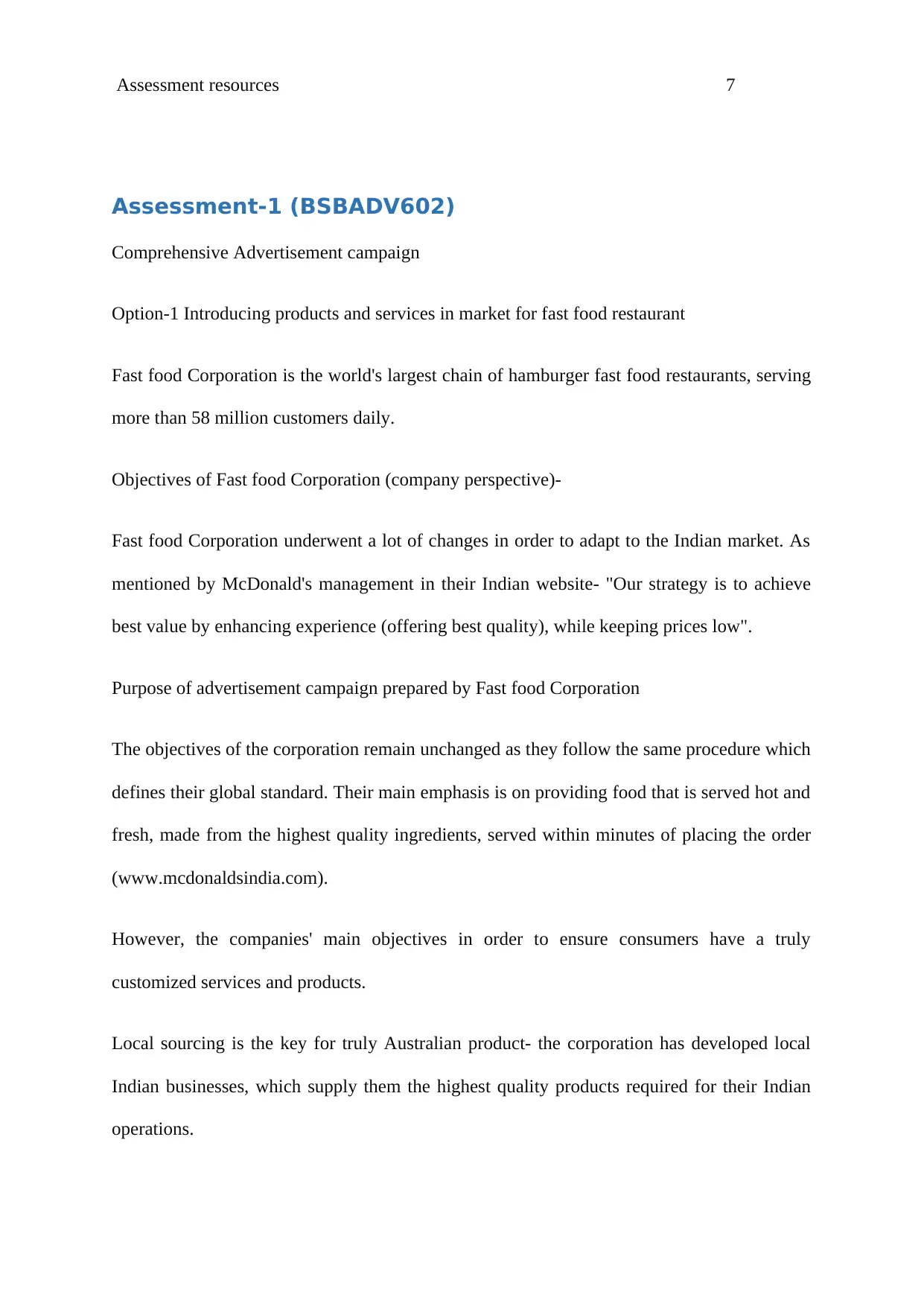
Assessment resources 7
Assessment-1 (BSBADV602)
Comprehensive Advertisement campaign
Option-1 Introducing products and services in market for fast food restaurant
Fast food Corporation is the world's largest chain of hamburger fast food restaurants, serving
more than 58 million customers daily.
Objectives of Fast food Corporation (company perspective)-
Fast food Corporation underwent a lot of changes in order to adapt to the Indian market. As
mentioned by McDonald's management in their Indian website- "Our strategy is to achieve
best value by enhancing experience (offering best quality), while keeping prices low".
Purpose of advertisement campaign prepared by Fast food Corporation
The objectives of the corporation remain unchanged as they follow the same procedure which
defines their global standard. Their main emphasis is on providing food that is served hot and
fresh, made from the highest quality ingredients, served within minutes of placing the order
(www.mcdonaldsindia.com).
However, the companies' main objectives in order to ensure consumers have a truly
customized services and products.
Local sourcing is the key for truly Australian product- the corporation has developed local
Indian businesses, which supply them the highest quality products required for their Indian
operations.
Assessment-1 (BSBADV602)
Comprehensive Advertisement campaign
Option-1 Introducing products and services in market for fast food restaurant
Fast food Corporation is the world's largest chain of hamburger fast food restaurants, serving
more than 58 million customers daily.
Objectives of Fast food Corporation (company perspective)-
Fast food Corporation underwent a lot of changes in order to adapt to the Indian market. As
mentioned by McDonald's management in their Indian website- "Our strategy is to achieve
best value by enhancing experience (offering best quality), while keeping prices low".
Purpose of advertisement campaign prepared by Fast food Corporation
The objectives of the corporation remain unchanged as they follow the same procedure which
defines their global standard. Their main emphasis is on providing food that is served hot and
fresh, made from the highest quality ingredients, served within minutes of placing the order
(www.mcdonaldsindia.com).
However, the companies' main objectives in order to ensure consumers have a truly
customized services and products.
Local sourcing is the key for truly Australian product- the corporation has developed local
Indian businesses, which supply them the highest quality products required for their Indian
operations.
Paraphrase This Document
Need a fresh take? Get an instant paraphrase of this document with our AI Paraphraser
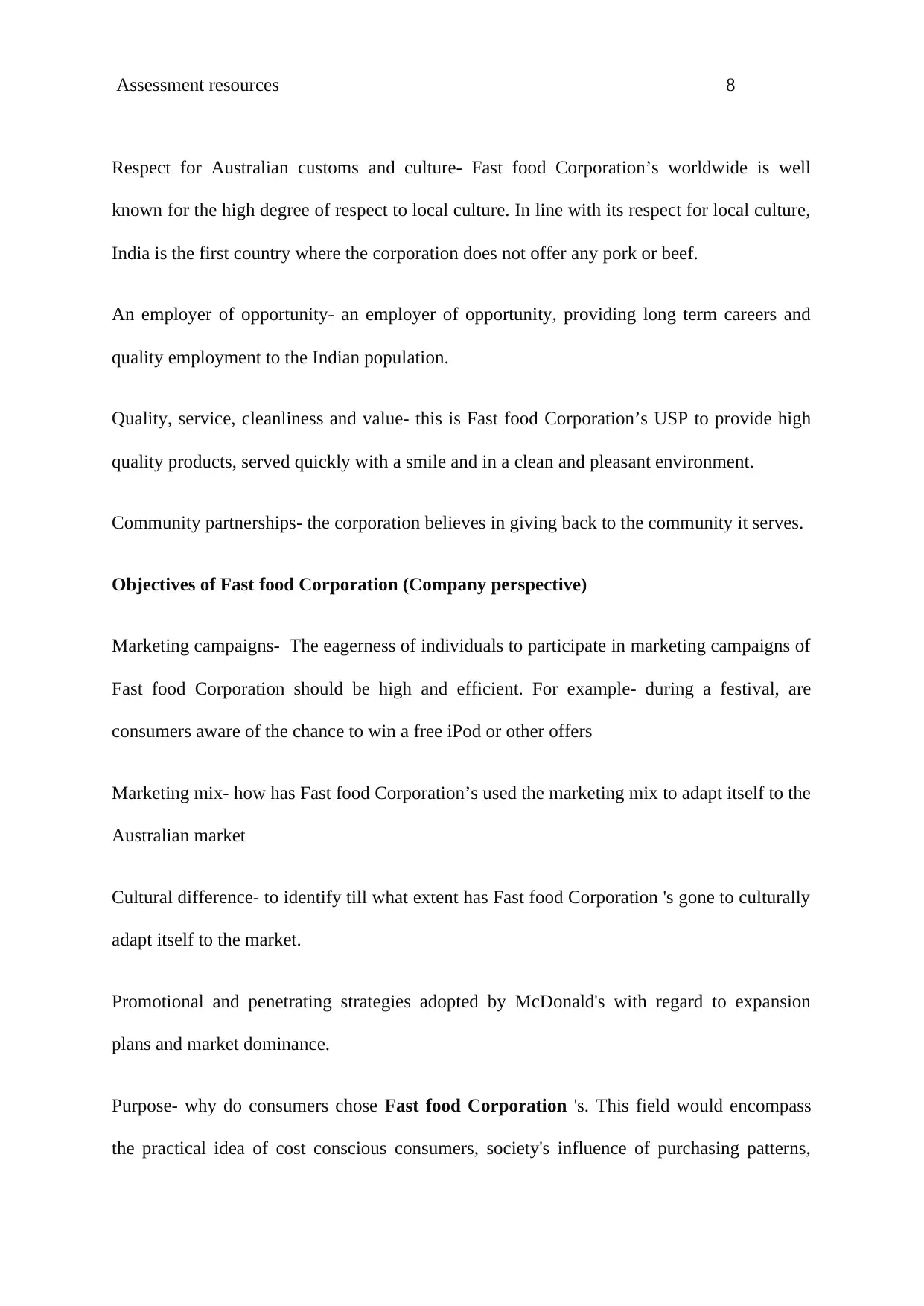
Assessment resources 8
Respect for Australian customs and culture- Fast food Corporation’s worldwide is well
known for the high degree of respect to local culture. In line with its respect for local culture,
India is the first country where the corporation does not offer any pork or beef.
An employer of opportunity- an employer of opportunity, providing long term careers and
quality employment to the Indian population.
Quality, service, cleanliness and value- this is Fast food Corporation’s USP to provide high
quality products, served quickly with a smile and in a clean and pleasant environment.
Community partnerships- the corporation believes in giving back to the community it serves.
Objectives of Fast food Corporation (Company perspective)
Marketing campaigns- The eagerness of individuals to participate in marketing campaigns of
Fast food Corporation should be high and efficient. For example- during a festival, are
consumers aware of the chance to win a free iPod or other offers
Marketing mix- how has Fast food Corporation’s used the marketing mix to adapt itself to the
Australian market
Cultural difference- to identify till what extent has Fast food Corporation 's gone to culturally
adapt itself to the market.
Promotional and penetrating strategies adopted by McDonald's with regard to expansion
plans and market dominance.
Purpose- why do consumers chose Fast food Corporation 's. This field would encompass
the practical idea of cost conscious consumers, society's influence of purchasing patterns,
Respect for Australian customs and culture- Fast food Corporation’s worldwide is well
known for the high degree of respect to local culture. In line with its respect for local culture,
India is the first country where the corporation does not offer any pork or beef.
An employer of opportunity- an employer of opportunity, providing long term careers and
quality employment to the Indian population.
Quality, service, cleanliness and value- this is Fast food Corporation’s USP to provide high
quality products, served quickly with a smile and in a clean and pleasant environment.
Community partnerships- the corporation believes in giving back to the community it serves.
Objectives of Fast food Corporation (Company perspective)
Marketing campaigns- The eagerness of individuals to participate in marketing campaigns of
Fast food Corporation should be high and efficient. For example- during a festival, are
consumers aware of the chance to win a free iPod or other offers
Marketing mix- how has Fast food Corporation’s used the marketing mix to adapt itself to the
Australian market
Cultural difference- to identify till what extent has Fast food Corporation 's gone to culturally
adapt itself to the market.
Promotional and penetrating strategies adopted by McDonald's with regard to expansion
plans and market dominance.
Purpose- why do consumers chose Fast food Corporation 's. This field would encompass
the practical idea of cost conscious consumers, society's influence of purchasing patterns,
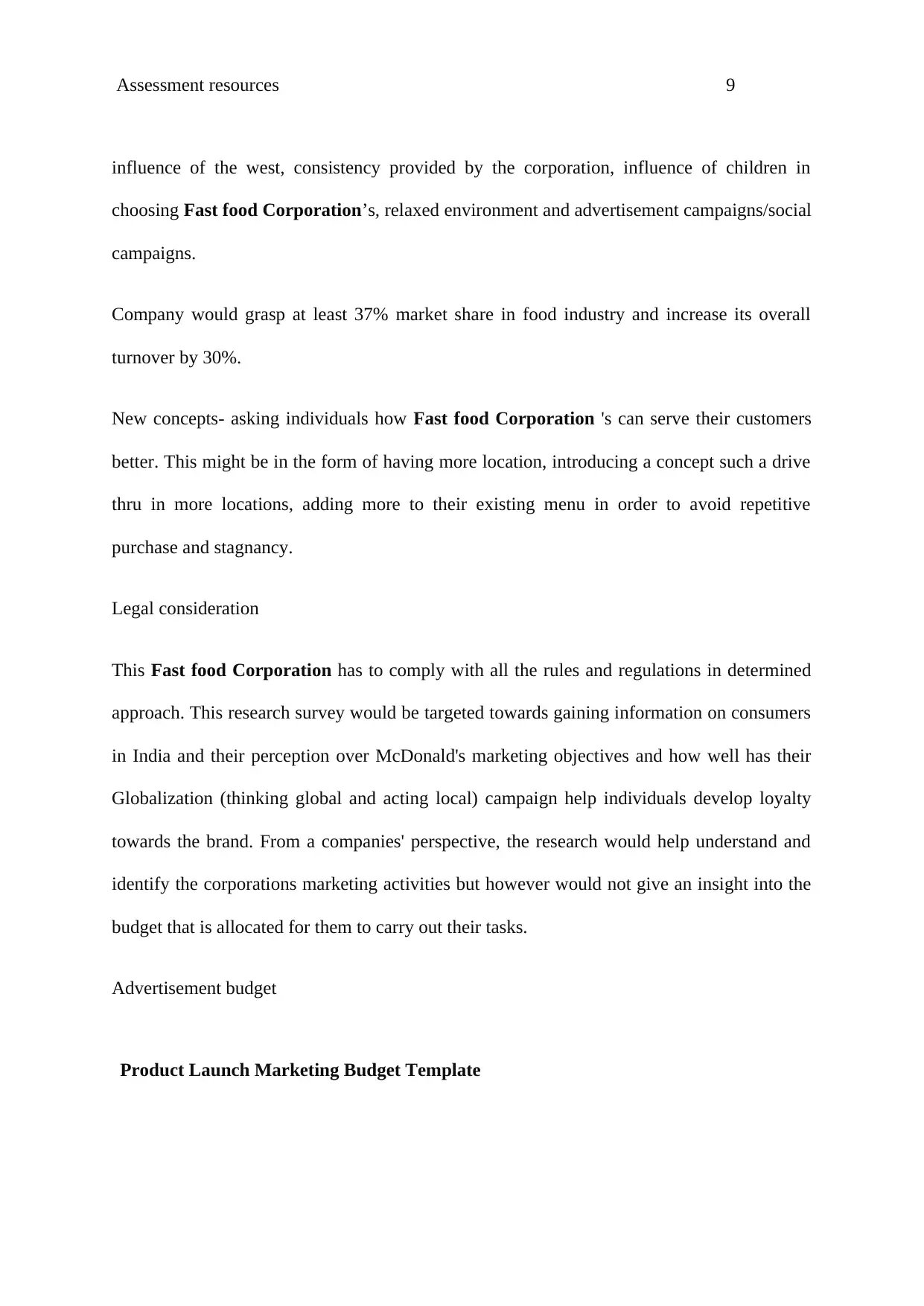
Assessment resources 9
influence of the west, consistency provided by the corporation, influence of children in
choosing Fast food Corporation’s, relaxed environment and advertisement campaigns/social
campaigns.
Company would grasp at least 37% market share in food industry and increase its overall
turnover by 30%.
New concepts- asking individuals how Fast food Corporation 's can serve their customers
better. This might be in the form of having more location, introducing a concept such a drive
thru in more locations, adding more to their existing menu in order to avoid repetitive
purchase and stagnancy.
Legal consideration
This Fast food Corporation has to comply with all the rules and regulations in determined
approach. This research survey would be targeted towards gaining information on consumers
in India and their perception over McDonald's marketing objectives and how well has their
Globalization (thinking global and acting local) campaign help individuals develop loyalty
towards the brand. From a companies' perspective, the research would help understand and
identify the corporations marketing activities but however would not give an insight into the
budget that is allocated for them to carry out their tasks.
Advertisement budget
Product Launch Marketing Budget Template
influence of the west, consistency provided by the corporation, influence of children in
choosing Fast food Corporation’s, relaxed environment and advertisement campaigns/social
campaigns.
Company would grasp at least 37% market share in food industry and increase its overall
turnover by 30%.
New concepts- asking individuals how Fast food Corporation 's can serve their customers
better. This might be in the form of having more location, introducing a concept such a drive
thru in more locations, adding more to their existing menu in order to avoid repetitive
purchase and stagnancy.
Legal consideration
This Fast food Corporation has to comply with all the rules and regulations in determined
approach. This research survey would be targeted towards gaining information on consumers
in India and their perception over McDonald's marketing objectives and how well has their
Globalization (thinking global and acting local) campaign help individuals develop loyalty
towards the brand. From a companies' perspective, the research would help understand and
identify the corporations marketing activities but however would not give an insight into the
budget that is allocated for them to carry out their tasks.
Advertisement budget
Product Launch Marketing Budget Template
⊘ This is a preview!⊘
Do you want full access?
Subscribe today to unlock all pages.

Trusted by 1+ million students worldwide
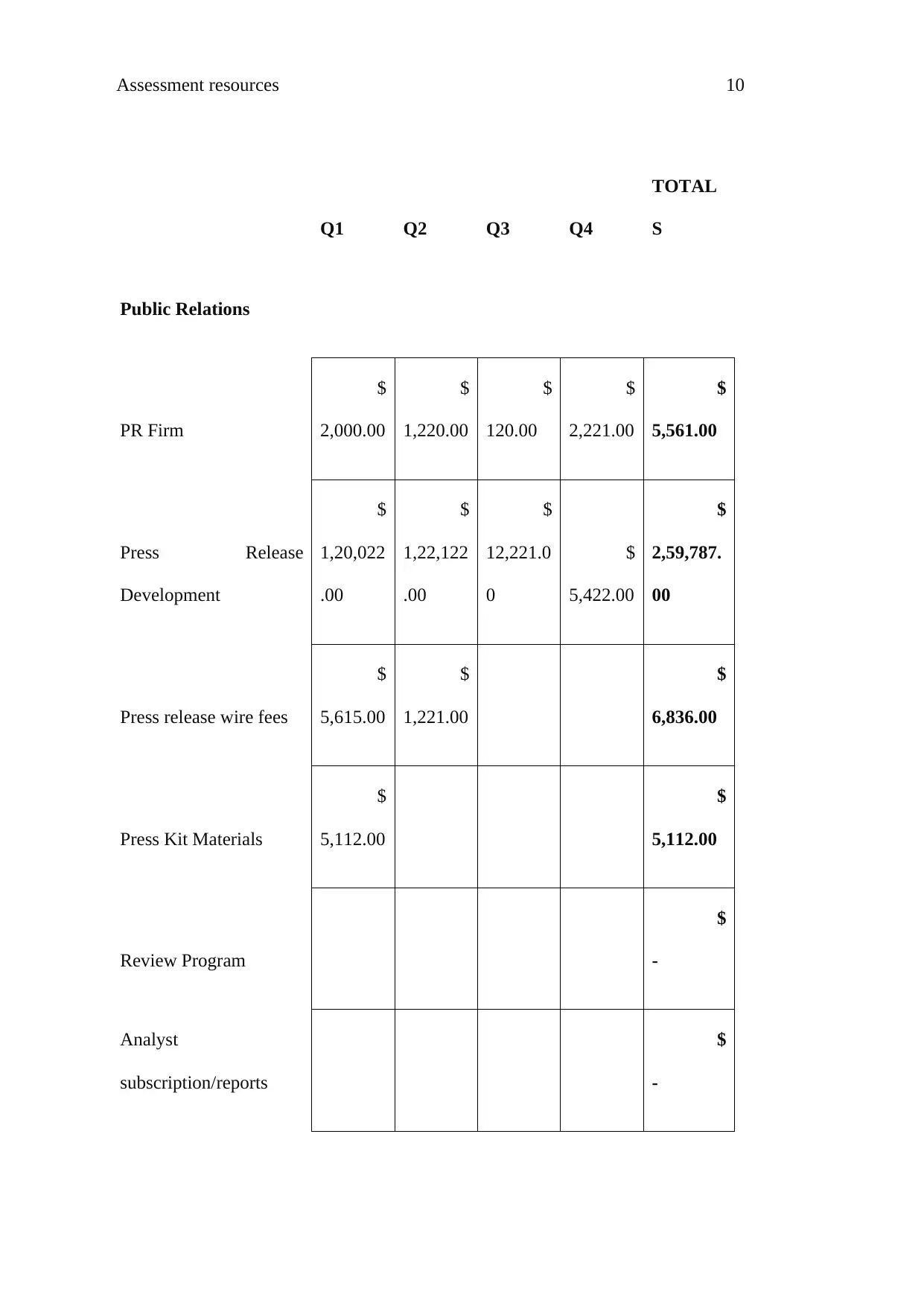
Assessment resources 10
Q1 Q2 Q3 Q4
TOTAL
S
Public Relations
PR Firm
$
2,000.00
$
1,220.00
$
120.00
$
2,221.00
$
5,561.00
Press Release
Development
$
1,20,022
.00
$
1,22,122
.00
$
12,221.0
0
$
5,422.00
$
2,59,787.
00
Press release wire fees
$
5,615.00
$
1,221.00
$
6,836.00
Press Kit Materials
$
5,112.00
$
5,112.00
Review Program
$
-
Analyst
subscription/reports
$
-
Q1 Q2 Q3 Q4
TOTAL
S
Public Relations
PR Firm
$
2,000.00
$
1,220.00
$
120.00
$
2,221.00
$
5,561.00
Press Release
Development
$
1,20,022
.00
$
1,22,122
.00
$
12,221.0
0
$
5,422.00
$
2,59,787.
00
Press release wire fees
$
5,615.00
$
1,221.00
$
6,836.00
Press Kit Materials
$
5,112.00
$
5,112.00
Review Program
$
-
Analyst
subscription/reports
$
-
Paraphrase This Document
Need a fresh take? Get an instant paraphrase of this document with our AI Paraphraser
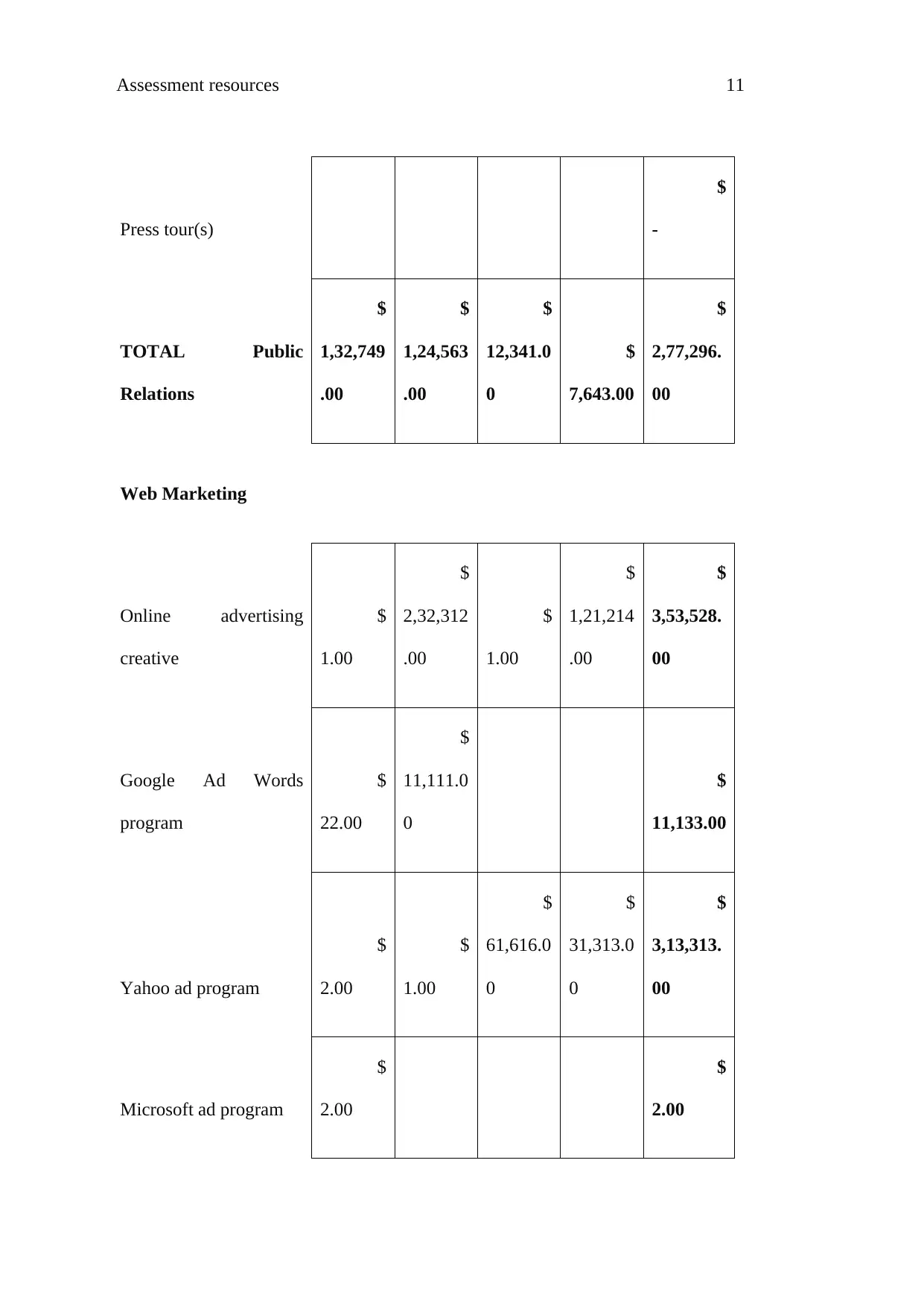
Assessment resources 11
Press tour(s)
$
-
TOTAL Public
Relations
$
1,32,749
.00
$
1,24,563
.00
$
12,341.0
0
$
7,643.00
$
2,77,296.
00
Web Marketing
Online advertising
creative
$
1.00
$
2,32,312
.00
$
1.00
$
1,21,214
.00
$
3,53,528.
00
Google Ad Words
program
$
22.00
$
11,111.0
0
$
11,133.00
Yahoo ad program
$
2.00
$
1.00
$
61,616.0
0
$
31,313.0
0
$
3,13,313.
00
Microsoft ad program
$
2.00
$
2.00
Press tour(s)
$
-
TOTAL Public
Relations
$
1,32,749
.00
$
1,24,563
.00
$
12,341.0
0
$
7,643.00
$
2,77,296.
00
Web Marketing
Online advertising
creative
$
1.00
$
2,32,312
.00
$
1.00
$
1,21,214
.00
$
3,53,528.
00
Google Ad Words
program
$
22.00
$
11,111.0
0
$
11,133.00
Yahoo ad program
$
2.00
$
1.00
$
61,616.0
0
$
31,313.0
0
$
3,13,313.
00
Microsoft ad program
$
2.00
$
2.00
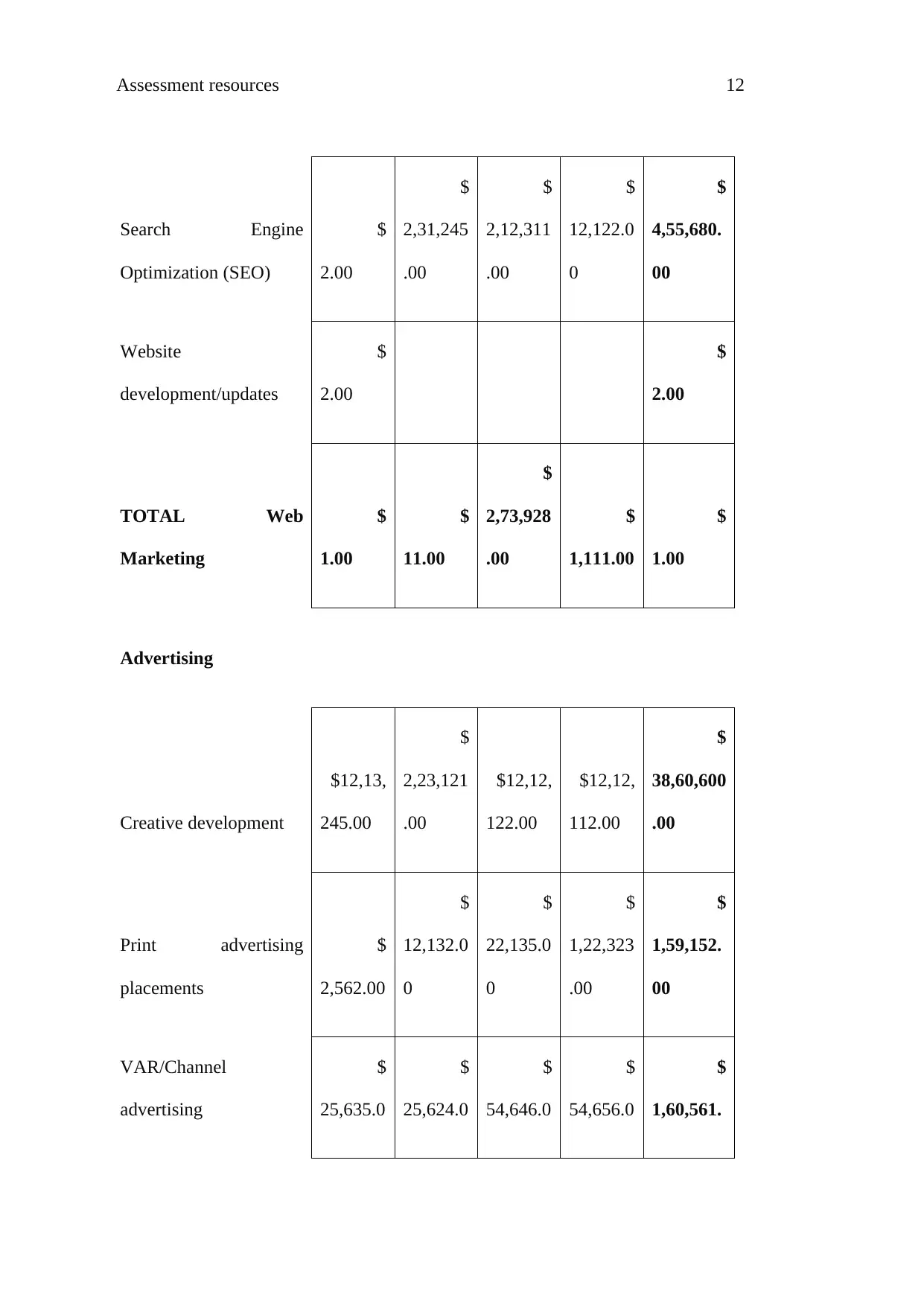
Assessment resources 12
Search Engine
Optimization (SEO)
$
2.00
$
2,31,245
.00
$
2,12,311
.00
$
12,122.0
0
$
4,55,680.
00
Website
development/updates
$
2.00
$
2.00
TOTAL Web
Marketing
$
1.00
$
11.00
$
2,73,928
.00
$
1,111.00
$
1.00
Advertising
Creative development
$12,13,
245.00
$
2,23,121
.00
$12,12,
122.00
$12,12,
112.00
$
38,60,600
.00
Print advertising
placements
$
2,562.00
$
12,132.0
0
$
22,135.0
0
$
1,22,323
.00
$
1,59,152.
00
VAR/Channel
advertising
$
25,635.0
$
25,624.0
$
54,646.0
$
54,656.0
$
1,60,561.
Search Engine
Optimization (SEO)
$
2.00
$
2,31,245
.00
$
2,12,311
.00
$
12,122.0
0
$
4,55,680.
00
Website
development/updates
$
2.00
$
2.00
TOTAL Web
Marketing
$
1.00
$
11.00
$
2,73,928
.00
$
1,111.00
$
1.00
Advertising
Creative development
$12,13,
245.00
$
2,23,121
.00
$12,12,
122.00
$12,12,
112.00
$
38,60,600
.00
Print advertising
placements
$
2,562.00
$
12,132.0
0
$
22,135.0
0
$
1,22,323
.00
$
1,59,152.
00
VAR/Channel
advertising
$
25,635.0
$
25,624.0
$
54,646.0
$
54,656.0
$
1,60,561.
⊘ This is a preview!⊘
Do you want full access?
Subscribe today to unlock all pages.

Trusted by 1+ million students worldwide
1 out of 163
Your All-in-One AI-Powered Toolkit for Academic Success.
+13062052269
info@desklib.com
Available 24*7 on WhatsApp / Email
![[object Object]](/_next/static/media/star-bottom.7253800d.svg)
Unlock your academic potential
Copyright © 2020–2025 A2Z Services. All Rights Reserved. Developed and managed by ZUCOL.